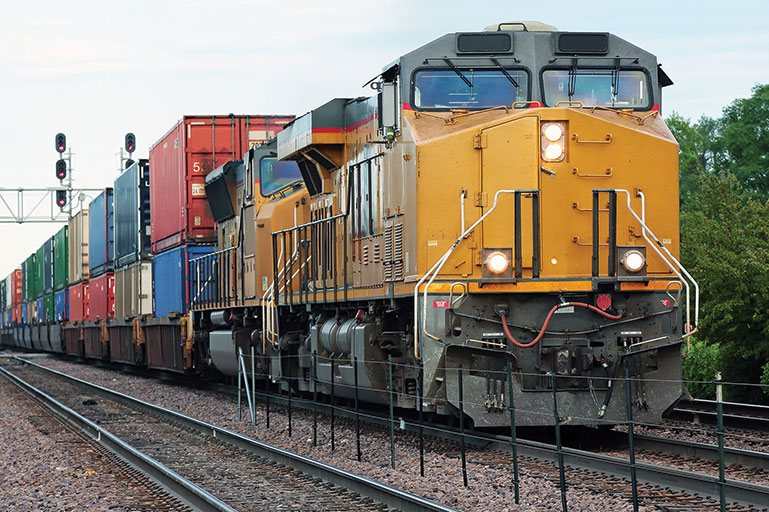Fourth quarter and calendar year 2022 intermodal volumes see annual declines, reports IANA
For the fourth quarter, IANA reported that total intermodal volume—at 4,237,605 units—were off compared to the fourth quarter 2021. Total calendar year 2022 volume—at 17,716,445 units—were down 3.9% compared to 2021.
Fourth quarter and calendar year 2022 intermodal volumes each saw annual declines, according to the most recent edition of the “Intermodal Quarterly” report, which was recently issued by the Intermodal Association of North America (IANA).
For the fourth quarter, IANA reported that total intermodal volume—at 4,237,605 units—were off compared to the fourth quarter 2021. Trailers again saw the steepest annual decline, falling 29.7%, to 215,272, and domestic containers—at 1,989,566—decreased 4.2%, for its only negative quarter in 2022. All domestic equipment, which is comprised of trailers and domestic containers, was off 7.5%, to 2,204,938. ISO, or international containers, eked out a 0.9% increase, to 2,032,367. IANA said that the ISO gain reflects significant weakness, for the segment, in the fourth quarter 2021, when volumes saw a 16.2% decline.
Total calendar year 2022 volume—at 17,716,445 units—were down 3.9% compared to 2021. Trailers fell 23.8%, to 924,259, and domestic containers were the lone segment to see an annual gain, rising 1.6%, to 8,147,044, after a 2.3% annual gain in 2021. All domestic equipment fell 1.8%, to 9,071,303. ISO containers were down 6.0%, to 8,645,142, following a 5.0% annual gain in 2021. With this annual decline, total intermodal volumes have been down in three of the last four years, and on a quarterly basis, the fourth quarter tally represents the sixth straight month of declining volumes, as well as one of the lowest-volume quarters going back to 2013.
IANA explained, in the report, that throughout 2022, intermodal network fluidity saw improvement but was impacted by a whole host of issues, including: terminal congestion shortages; the threat of a U.S. rail strike; unresolved West Coast port labor negotiations; and ongoing warehouse overcrowding. But that comes with a caveat, according to IANA, in that these gains in intermodal network fluidity occurred “at a time when the economy was slowing, with fewer imports and domestically produced goods being shipped.”
When asked if fourth quarter and calendar year 2022 volumes were in line with expectations, IANA President and CEO Joni Casey told LM that initial expectations were for a positive outcome, as total intermodal volume had been forecasted to rise 2.9%, for calendar year 2022. But, as things turned out, she noted that intermodal loadings were down in each quarter of 2022.
Even though there were gains in network fluidity over the course of 2022, Casey highlighted two import trends that benefitted from that fluidity, in terms of supply chain gains.
“[T]he shift to East and Gulf Coast ports as well as the ‘flattening of peak season…it's likely that both will have some ‘stickiness’ and result in improvements during 2023,” she said. “The shift to services impacts the entire freight transportation system, including intermodal, and remains a variable this year.”
Another factor to keep an eye on in 2023, is the ongoing shift in consumer spending preferences, from goods to services, which Casey said impacts the entire freight transportation system, including intermodal, and remains a variable in 2023.
In its 2023 intermodal outlook, IANA observed that with goods consumption levels heading down, coupled with slower job growth and the personal savings rate near a record low, the likelihood of near-term growth in goods demand are viewed as remote. And it added that while industrial production and manufacturing output saw declines in the fourth quarter, new orders for manufactured goods are showing signs of pent-up demand. Other things to monitor in 2023, identified by IANA included a still-tight housing market creating “upside potential” for residential construction, should mortgage rates see further declines off of very high 2022 levels. It also pointed to inventories as “a freight demand factor” is comprised of near-term downside risks, with inventories-to-sale ratios in a normal range, although based on retail sales having seen recent declines.
IANA also cited how trucking capacity is viewed as a wild card, due to a currently stagnant freight outlook, with a potential loss of drivers due to freight weakness or a capacity shift towards larger carriers.













